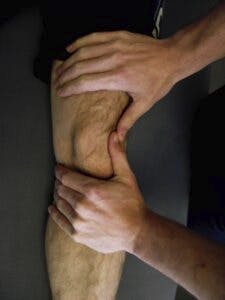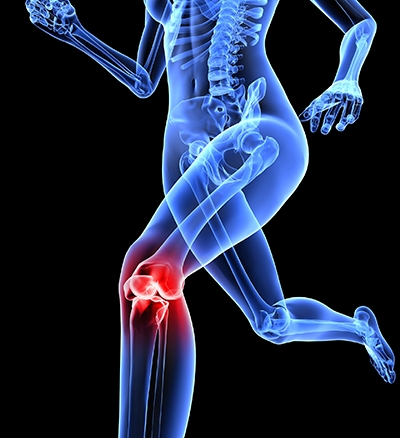Patellofemoral pain syndrome refers to pain in the front of your knee or around your kneecap (patella). It is the most common form of knee pain. Patellofemoral pain syndrome is sometimes referred to as runner’s knee. However, anyone can get it. It commonly affects runners, cyclists, office workers, or anyone else who sits for long periods. Patellofemoral pain syndrome is also very common in teens, particularly girls.
Pain often occurs when friction is created between the undersurface of the kneecap and the thigh bone (femur). Tenderness can be found along the edges of the kneecap. The ligaments and soft tissues surrounding the knee cap can also become sensitive. Changes within the nervous system may lead to the area of pain spreading to other areas of the knee.
Pain is often experienced with the following activities:
- Walking up or down stairs
- Walking on uneven surfaces
- Squatting or standing up from a chair
- Pain that increases with activity and improves with rest
- After sitting for long periods with the knee bent
- A “crack” or “pop” when bending or straightening the knee
Tracking of the Kneecap
![]()
Anatomy allows the kneecap to slide smoothly on the femur in a groove (situated along the thigh bone) during movement. Excessive friction between the undersurface of the kneecap and the femur can occur when your kneecap moves slightly out of this groove. This is similar to a train sliding slightly off its track.
The kneecap may fail to track properly in its groove when the quadriceps muscle on the inside front of the thigh is weak. Weakness of the hip muscles may also cause the track (femur) to move underneath the train (kneecap). Also, the kneecap is pulled in the direction of any tight muscles or ligaments. Any of these factors can cause your kneecap to track or tilt to the side, which irritates the tissues around the kneecap.
Physical Therapy for Patellofemoral Pain Syndrome
Manual therapy performed by a licensed physical therapist alleviates pain from patellofemoral pain syndrome. Joint mobilization involves stretching the ligaments that attach to the kneecap. This improves mobility of the kneecap allowing it to remain situated in its normal groove. Soft tissue techniques to the surrounding muscles also alleviate pain and improve mobility of the kneecap. Common muscles treated include the hamstrings, quadriceps, and iliotibial band.

Strengthening exercise is the foundation of any rehab program for patellofemoral pain syndrome. Research indicates strengthening exercise for the quadriceps and hip muscles is the most effective intervention for this condition. Initial exercises should be pain-free. Exercise is started in non-weight-bearing or lying positions. Examples include the clamshell or bridge. Once a baseline level of strength has been established, standing or weight-bearing exercises are performed.
Rehabilitation involves improving poor movement patterns. To uncover the cause of pain or poor movement, whole movement patterns must be assessed and treated. For individuals with pain in the front of their knee, isolated treatments to the knee rarely provide complete relief. The brain stores patterns of movement and then signals muscles to execute what is believed to be the most efficient pattern. With the repeated performance of compensatory movement patterns, the abnormal becomes the new normal. These patterns can be reprogrammed and corrected with appropriate movement training by physical therapists.
See Your Physical Therapist for More Help with Kneecap Pain
Exercise is the most effective treatment for people with patellofemoral pain syndrome. Less than 5% of people with this problem will undergo surgery. The long-term success of these surgeries is questionable at best. Physical therapists prescribe individualized exercise programs unique to your needs and goals. Of course, the long-term success of any exercise program is dependent on consistency and discipline.
To develop the best exercise program, contact your physical therapist and schedule an initial evaluation.

